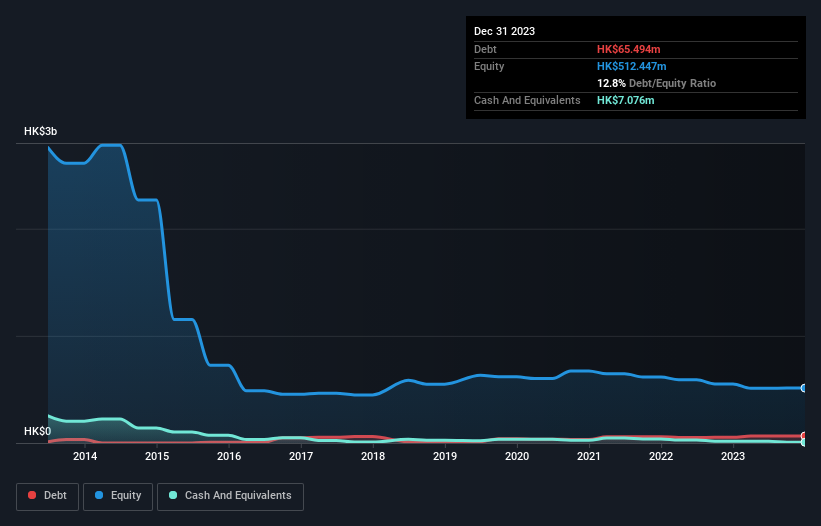Some say volatility, rather than debt, is the best way to think about risk as an investor, but Warren Buffett famously said that 'Volatility is far from synonymous with risk.' So it seems the smart money knows that debt - which is usually involved in bankruptcies - is a very important factor, when you assess how risky a company is. Importantly, Brockman Mining Limited (HKG:159) does carry debt. But the real question is whether this debt is making the company risky.
When Is Debt Dangerous?
Debt is a tool to help businesses grow, but if a business is incapable of paying off its lenders, then it exists at their mercy. If things get really bad, the lenders can take control of the business. However, a more frequent (but still costly) occurrence is where a company must issue shares at bargain-basement prices, permanently diluting shareholders, just to shore up its balance sheet. By replacing dilution, though, debt can be an extremely good tool for businesses that need capital to invest in growth at high rates of return. When we think about a company's use of debt, we first look at cash and debt together.
View our latest analysis for Brockman Mining
What Is Brockman Mining's Debt?
You can click the graphic below for the historical numbers, but it shows that as of December 2023 Brockman Mining had HK$65.5m of debt, an increase on HK$53.5m, over one year. However, it also had HK$7.08m in cash, and so its net debt is HK$58.4m.

How Strong Is Brockman Mining's Balance Sheet?
Zooming in on the latest balance sheet data, we can see that Brockman Mining had liabilities of HK$67.5m due within 12 months and liabilities of HK$151.2m due beyond that. On the other hand, it had cash of HK$7.08m and HK$1.71m worth of receivables due within a year. So its liabilities total HK$210.0m more than the combination of its cash and short-term receivables.
Brockman Mining has a market capitalization of HK$955.9m, so it could very likely raise cash to ameliorate its balance sheet, if the need arose. However, it is still worthwhile taking a close look at its ability to pay off debt. When analysing debt levels, the balance sheet is the obvious place to start. But it is Brockman Mining's earnings that will influence how the balance sheet holds up in the future. So if you're keen to discover more about its earnings, it might be worth checking out this graph of its long term earnings trend.
Given its lack of meaningful operating revenue, investors are probably hoping that Brockman Mining finds some valuable resources, before it runs out of money.
Caveat Emptor
Over the last twelve months Brockman Mining produced an earnings before interest and tax (EBIT) loss. To be specific the EBIT loss came in at HK$45m. When we look at that and recall the liabilities on its balance sheet, relative to cash, it seems unwise to us for the company to have any debt. Quite frankly we think the balance sheet is far from match-fit, although it could be improved with time. Another cause for caution is that is bled HK$19m in negative free cash flow over the last twelve months. So to be blunt we think it is risky. The balance sheet is clearly the area to focus on when you are analysing debt. However, not all investment risk resides within the balance sheet - far from it. For example, we've discovered 3 warning signs for Brockman Mining that you should be aware of before investing here.
At the end of the day, it's often better to focus on companies that are free from net debt. You can access our special list of such companies (all with a track record of profit growth). It's free.
Valuation is complex, but we're here to simplify it.
Discover if Brockman Mining might be undervalued or overvalued with our detailed analysis, featuring fair value estimates, potential risks, dividends, insider trades, and its financial condition.
Access Free AnalysisHave feedback on this article? Concerned about the content? Get in touch with us directly. Alternatively, email editorial-team (at) simplywallst.com.
This article by Simply Wall St is general in nature. We provide commentary based on historical data and analyst forecasts only using an unbiased methodology and our articles are not intended to be financial advice. It does not constitute a recommendation to buy or sell any stock, and does not take account of your objectives, or your financial situation. We aim to bring you long-term focused analysis driven by fundamental data. Note that our analysis may not factor in the latest price-sensitive company announcements or qualitative material. Simply Wall St has no position in any stocks mentioned.
About SEHK:159
Brockman Mining
An investment holding company, engages in the exploration and development of iron ore mining projects in Australia and Hong Kong.
Slight risk with imperfect balance sheet.
Similar Companies
Market Insights
Community Narratives



